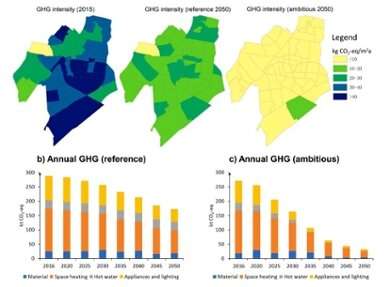How Dutch houses can become almost energy- and CO2-neutral

How much energy and greenhouse gas emissions can Dutch homes save? Xining Yang uses Leiden as an example and shows with his research how enormous the impact can be. At least, if we work harder on becoming more sustainable. Based on the models he developed, Yang will receive his doctorate on 28 June.
It will be difficult, but it is still possible: in 2050, the Netherlands must emit 95% less greenhouse gases than in 1990. In 2030, emissions must be reduced by 49%. Making the existing housing stock emission-free is an important part of these climate objectives. At the Leiden Institute for Environmental Sciences, Xining Yang developed models that provide insight into this.
Residential energy consumption and greenhouse gas emissions
Yang: "My models cover all of the roughly six million Dutch residential buildings, from single-family homes to tower blocks. They give an indication of energy consumption and greenhouse gas emissions up to 2050 under different policy scenarios. They also show the amount of building material needed for various scenarios." In order to make his models, he used a wide range of data. For example from the BAG (Base Registers of Addresses and Buildings), weather data from the KNMI (Koninklijk Nederlands Meteorologisch Instituut) and data on various types of housing.
Yang included year of construction, height, floor area and estimated energy consumption in his models. "Of course, people's behavior also matters a lot. For example, how hot they heat their homes and whether they have taken any insulation measures. In my models you can include scenarios for these measures and show how much effect they have."
Leiden as an example
As an example, Yang shows how greenhouse gas emissions are distributed across the various residential districts of Leiden. He also shows how this could change if we continue on our current path of increasing sustainability, and also if we become more ambitious. The latter means: applying all possible climate measures to the maximum.
Heating costs the most energy
"Most of the energy consumed by homes is used to heat the rooms," says Yang. In Leiden, that is about 600 gigaWatt-hours now. In 2050, it will be 400 in the conventional scenario. That is: current heat sources stay unchanged and buildings are only renovated due to aging and not actively made sustainable.
Leiden's energy consumption for heating could be reduced much further, to 150 gigaWatt-hours, if we do our utmost to insulate all homes optimally and use alternative natural-gas-free heating systems. For example electric heat pumps using green electricity.
Insulating all homes district by district?
Yang's models show how attractive it is to take on all the houses. There are ideas, both technical and financial, to achieve this. For example, pension funds could advance the investment and then recoup it with a good return. After the intervention, homeowners have almost no more energy costs, they only have to pay off the resulting energy mortgage to the pension fund. These kinds of ideas are not part of Yang's research, but he hopes to promote them. "I hope my models will help policymakers assess where the most opportunities lie and what the best strategies are for making the housing stock more sustainable."
Hot water, lighting and other activities from renewable energy
"If heating takes almost no energy anymore, you are only left with the need for energy for hot water, lighting and other activities: about 150 gigaWatt-hours each. If we get all that from renewable energy, including solar panels on all the available roofs, that energy use can be completely emission-free."
Greenhouse gas emissions can be cut by 90%
Yang focused only on residential buildings. "That's because they are fairly uniform in their energy use. A factory, restaurant or supermarket has a very different use." If we stick to the reference scenario, in which we continue to make buildings more sustainable at the current rate, annual greenhouse gas emissions from the housing stock will fall by around 40% in 2050 compared to 1990. If we really do everything we can, which is the ambitious scenario in Yang's models, it could fall by 90%.
















